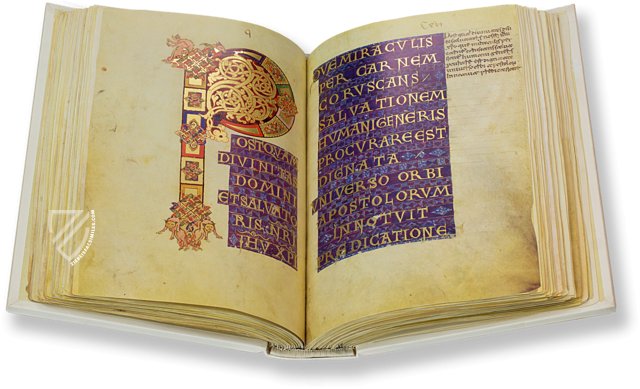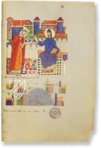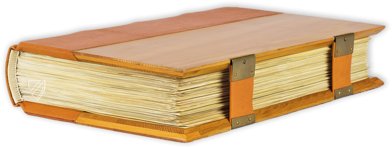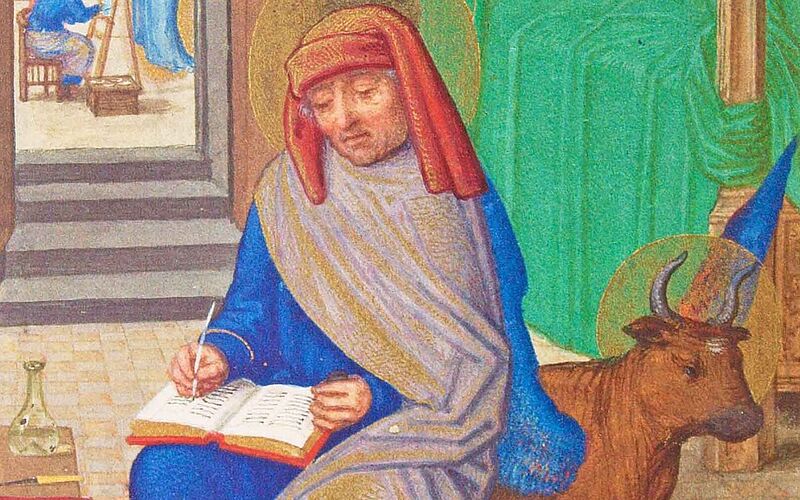Codex Benedictus
(over 10,000€)
In the heyday of the famous Benedictine Abbey of Montecassino in Italy, the influential Abbot Desiderius, who decisively advanced the monastery, commissioned a magnificent manuscript in honor of the abbey's founder, St. Benedict. With its prayers and poems, the beautifully illuminated Lectionary not only provides a unique insight into the life of the Saint and his two siblings Scholastica and Maur during the transitional period from antiquity to the Middle Ages, but also conveys a fascinating impression of everyday life at the monastery of Montecassino. This is mainly due to the 94 colorful and gold-decorated narrative miniatures, which come in all sizes. A special visual treat are also the sumptuous golden interlace initials, most of which are decorated with zoomorphic figures and often take up entire pages. Precious gold script on purple backgrounds repeatedly rounds off this opulence. Thus, the codex is a wonderful testimony to the prosperity of the abbey as well as the pious reverence of the friars for their order's founder.
Codex Benedictus
Around the year 529, St. Benedict founded the Montecassino Abbey in Italy. Under the direction of Abbot Desiderius from 1058 to 1085, the monastery became one of the important cultural centers of Europe. The monastic scriptorium of Montecassino produced some of the most significant Romanesque manuscripts. A treasure from this scriptorium is the Codex Benedictus, which was created in memory of the monastery’s founding father. His life and works were recorded here in prayers, hymns, and illustrations. The codex was read from on church feasts and holidays during monastic services. The manuscript contains 66 large and small miniatures in fresh colors and gold elements.
A New Understanding of Spirituality
The Codex Benedictus originates from around 1075 and was commissioned by Abbot Desiderius. Different illuminators illustrated the book, in the middle of which stood the life of Saint Benedict. The codex also contains the stories of St. Maurus and St. Scholastica, the sister of St. Benedict. Its illustrations include references to alterations in monastic life: the clergy won increasing political power and influence during the epoch of Abbot Desiderius. The relationship between clerical and worldly power changed, the question of church hierarchy returned to the foreground. These current events distinctly influenced the illuminators of the Codex Benedictus. Themes that were addressed included chastity, financial income, and the connection to powerful worldly people.
Masterly Miniatures
The manuscript opens with an image scene, in which Abbot Desiderius presents the codex to St. Benedict. The Montecassino Abbey is depicted in the background in shining radiance. The possessions of the monastery sprawl into a landscape at the feet of both people. This pompous opening scene is followed by numerous additional vivid miniatures. The luminously colored depictions were made by several illuminators, an illustrator adorned the colorful picture with high-carat gold. Various heteromorphic miniatures are to be found in the work, sometimes scenes stretch across an entire page, sometimes several smaller miniatures are arranged next to one another. Important events from the life of St. Benedict and his abbey were emphasized in a wide variety of different ways. Large, golden miniatures ennoble the beautiful manuscript.
Codicology
- Alternative Titles
- Montecassino Lectionary
Lektionar des Desiderius von Montecassino
Lektionar zu den Festen des Heiligen Benedikt
Cassinese Lectionary - Size / Format
- 524 pages / 37.0 × 25.0 cm
- Origin
- Italy
- Date
- Ca. 1070
- Epochs
- Style
- Language
- Script
- Beneventan script
- Illustrations
- 65 larger and smaller miniatures depicting the life of Benedict and 29 on the life of Maur; several decorated initials, some full-page, and chrysography
- Content
- Lives of St. Benedict, St. Scholastica (his twin sister), and St. Maurus (his first disciple)
- Patron
- Abbot Desiderius (ca. 1026–87)
- Artist / School
- Leone (scribe)
Byzantine influences - Previous Owners
- Montecassino Abbey
Codex Benedictus
Casting out the Devil
Aside from being the most influential figure of Christian monasticism during the Early Middle Ages, one of the miracles associated with Saint Benedict was when he performed an exorcism on a priest who was possessed by the devil. As a result, the Saint Benedict Medal has an abbreviation on its reverse side which stands for VADE RETRO SATANA or "Begone, Satan!" The exorcism is depicted quite literally with Saint Benedict appearing to slap the devil out of the mouth of the afflicted priest.

Codex Benedictus
Presentation Miniature
The opening scene of this Romanesque manuscript shows an archetypal “presentation miniature” in which Abbot Desiderius presents the codex at hand to St. Benedict. The square halo of Desiderius indicates that he is alive while Benedict’s round halo indicates that he is receiving the gift posthumously. The color palette of red, blue, green, and gold is typical of luxury Romanesque manuscripts.
Montecassino Abbey is depicted shining in the background of the image, its possessions sprawling out into the landscape at the feet of the two figures. Arches and a patterned floor indicate that the scene is occurring in an interior space within this grandiose architecture, innovatively depicting events inside while simultaneously representing the setting outside.
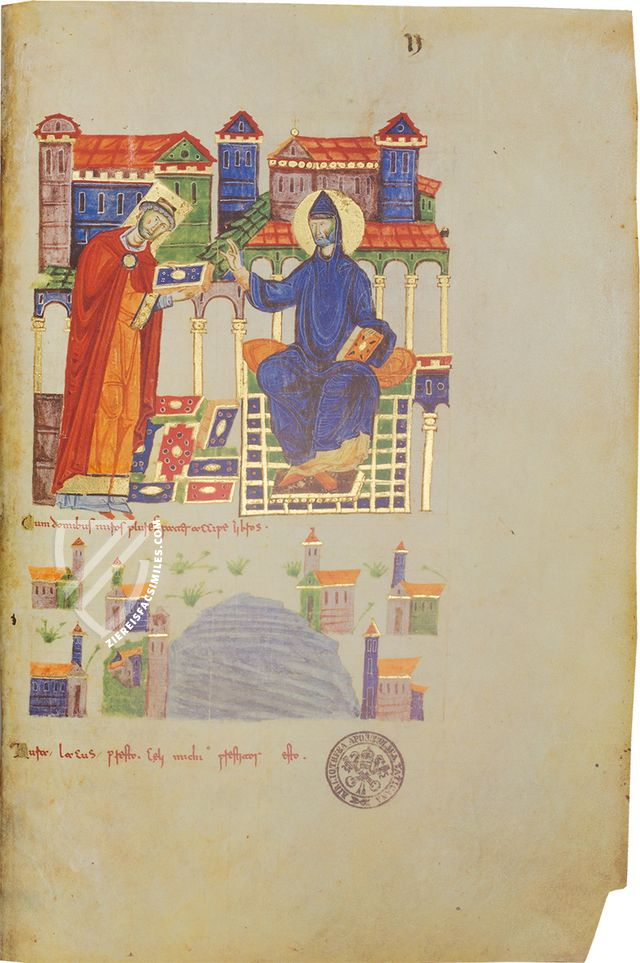
#1 Codex Benedictus (Pope Edition)
Language: German
(over 10,000€)
#2 Codex Benedictus (Standard edition)
Language: German
- Treatises / Secular Books
- Apocalypses / Beatus
- Astronomy / Astrology
- Bestiaries
- Bibles / Gospels
- Chronicles / History / Law
- Geography / Maps
- Saints' Lives
- Islam / Oriental
- Judaism / Hebrew
- Single Leaf Collections
- Leonardo da Vinci
- Literature / Poetry
- Liturgical Manuscripts
- Medicine / Botany / Alchemy
- Music
- Mythology / Prophecies
- Psalters
- Other Religious Books
- Games / Hunting
- Private Devotion Books
- Other Genres
- Afghanistan
- Armenia
- Austria
- Belgium
- Belize
- Bosnia and Herzegovina
- China
- Colombia
- Costa Rica
- Croatia
- Cyprus
- Czech Republic
- Denmark
- Egypt
- El Salvador
- Ethiopia
- France
- Germany
- Greece
- Guatemala
- Honduras
- Hungary
- India
- Iran
- Iraq
- Israel
- Italy
- Japan
- Jordan
- Kazakhstan
- Kyrgyzstan
- Lebanon
- Liechtenstein
- Luxembourg
- Mexico
- Morocco
- Netherlands
- Palestine
- Panama
- Peru
- Poland
- Portugal
- Romania
- Russia
- Serbia
- Spain
- Sri Lanka
- Sweden
- Switzerland
- Syria
- Tajikistan
- Turkey
- Turkmenistan
- Ukraine
- United Kingdom
- United States
- Uzbekistan
- Vatican City
- A. Oosthoek, van Holkema & Warendorf
- Aboca Museum
- Ajuntament de Valencia
- Akademie Verlag
- Akademische Druck- u. Verlagsanstalt (ADEVA)
- Aldo Ausilio Editore - Bottega d’Erasmo
- Alecto Historical Editions
- Alkuin Verlag
- Almqvist & Wiksell
- Amilcare Pizzi
- Andreas & Andreas Verlagsbuchhandlung
- Archa 90
- Archiv Verlag
- Archivi Edizioni
- Arnold Verlag
- ARS
- Ars Magna
- ArtCodex
- AyN Ediciones
- Azimuth Editions
- Badenia Verlag
- Bärenreiter-Verlag
- Belser Verlag
- Belser Verlag / WK Wertkontor
- Benziger Verlag
- Bernardinum Wydawnictwo
- BiblioGemma
- Biblioteca Apostolica Vaticana (Vaticanstadt, Vaticanstadt)
- Bibliotheca Palatina Faksimile Verlag
- Bibliotheca Rara
- Boydell & Brewer
- Bramante Edizioni
- Bredius Genootschap
- Brepols Publishers
- British Library
- C. Weckesser
- Caixa Catalunya
- Canesi
- CAPSA, Ars Scriptoria
- Caratzas Brothers, Publishers
- Carus Verlag
- Casamassima Libri
- Centrum Cartographie Verlag GmbH
- Chavane Verlag
- Christian Brandstätter Verlag
- Circulo Cientifico
- Club Bibliófilo Versol
- Club du Livre
- CM Editores
- Collegium Graphicum
- Collezione Apocrifa Da Vinci
- Comissão Nacional para as Comemorações dos Descobrimentos Portugueses
- Coron Verlag
- Corvina
- CTHS
- D. S. Brewer
- Damon
- De Agostini/UTET
- De Nederlandsche Boekhandel
- De Schutter
- Deuschle & Stemmle
- Deutscher Verlag für Kunstwissenschaft
- DIAMM
- Droz
- E. Schreiber Graphische Kunstanstalten
- Ediciones Boreal
- Ediciones Grial
- Ediclube
- Edições Inapa
- Edilan
- Editalia
- Edition Deuschle
- Edition Georg Popp
- Edition Leipzig
- Edition Libri Illustri
- Editiones Reales Sitios S. L.
- Éditions de l'Oiseau Lyre
- Editions Medicina Rara
- Editorial Casariego
- Editorial Mintzoa
- Editrice Antenore
- Editrice Velar
- Edizioni Edison
- Egeria, S.L.
- Eikon Editores
- Electa
- Emery Walker Limited
- Enciclopèdia Catalana
- Eos-Verlag
- Ephesus Publishing
- Ernst Battenberg
- Eugrammia Press
- Extraordinary Editions
- Fackelverlag
- Facsimila Art & Edition
- Facsimile Editions Ltd.
- Facsimilia Art & Edition Ebert KG
- Faksimile Verlag
- Feuermann Verlag
- Folger Shakespeare Library
- Franco Cosimo Panini Editore
- Friedrich Wittig Verlag
- Fundación Hullera Vasco-Leonesa
- G. Braziller
- Gabriele Mazzotta Editore
- Gebr. Mann Verlag
- Gesellschaft für graphische Industrie
- Getty Research Institute
- Giovanni Domenico de Rossi
- Giunti Editore
- Graffiti
- Grafica European Center of Fine Arts
- Guido Pressler
- Guillermo Blazquez
- Gustav Kiepenheuer
- H. N. Abrams
- Harrassowitz
- Harvard University Press
- Helikon
- Hendrickson Publishers
- Henning Oppermann
- Herder Verlag
- Hes & De Graaf Publishers
- Hoepli
- Holbein-Verlag
- Houghton Library
- Hugo Schmidt Verlag
- Idion Verlag
- Il Bulino, edizioni d'arte
- ILte
- Imago
- Insel Verlag
- Insel-Verlag Anton Kippenberger
- Instituto de Estudios Altoaragoneses
- Instituto Nacional de Antropología e Historia
- Introligatornia Budnik Jerzy
- Istituto dell'Enciclopedia Italiana - Treccani
- Istituto Ellenico di Studi Bizantini e Postbizantini
- Istituto Geografico De Agostini
- Istituto Poligrafico e Zecca dello Stato
- Italarte Art Establishments
- Jan Thorbecke Verlag
- Johnson Reprint Corporation
- Josef Stocker
- Josef Stocker-Schmid
- Jugoslavija
- Karl W. Hiersemann
- Kasper Straube
- Kaydeda Ediciones
- Kindler Verlag / Coron Verlag
- Kodansha International Ltd.
- Konrad Kölbl Verlag
- Kurt Wolff Verlag
- La Liberia dello Stato
- La Linea Editrice
- La Meta Editore
- Lambert Schneider
- Landeskreditbank Baden-Württemberg
- Leo S. Olschki
- Les Incunables
- Liber Artis
- Library of Congress
- Libreria Musicale Italiana
- Lichtdruck
- Lito Immagine Editore
- Lumen Artis
- Lund Humphries
- M. Moleiro Editor
- Maison des Sciences de l'homme et de la société de Poitiers
- Manuscriptum
- Martinus Nijhoff
- Maruzen-Yushodo Co. Ltd.
- MASA
- Massada Publishers
- McGraw-Hill
- Metropolitan Museum of Art
- Militos
- Millennium Liber
- Müller & Schindler
- Nahar - Stavit
- Nahar and Steimatzky
- National Library of Wales
- Neri Pozza
- Nova Charta
- Oceanum Verlag
- Odeon
- Orbis Mediaevalis
- Orbis Pictus
- Österreichische Staatsdruckerei
- Oxford University Press
- Pageant Books
- Parzellers Buchverlag
- Patrimonio Ediciones
- Pattloch Verlag
- PIAF
- Pieper Verlag
- Plon-Nourrit et cie
- Poligrafiche Bolis
- Presses Universitaires de Strasbourg
- Prestel Verlag
- Princeton University Press
- Prisma Verlag
- Priuli & Verlucca, editori
- Pro Sport Verlag
- Propyläen Verlag
- Pytheas Books
- Quaternio Verlag Luzern
- Reales Sitios
- Recht-Verlag
- Reichert Verlag
- Reichsdruckerei
- Reprint Verlag
- Riehn & Reusch
- Roberto Vattori Editore
- Rosenkilde and Bagger
- Roxburghe Club
- Salerno Editrice
- Saltellus Press
- Sandoz
- Sarajevo Svjetlost
- Schöck ArtPrint Kft.
- Schulsinger Brothers
- Scolar Press
- Scrinium
- Scripta Maneant
- Scriptorium
- Shazar
- Siloé, arte y bibliofilia
- SISMEL - Edizioni del Galluzzo
- Sociedad Mexicana de Antropología
- Société des Bibliophiles & Iconophiles de Belgique
- Soncin Publishing
- Sorli Ediciones
- Stainer and Bell
- Studer
- Styria Verlag
- Sumptibus Pragopress
- Szegedi Tudomànyegyetem
- Taberna Libraria
- Tarshish Books
- Taschen
- Tempus Libri
- Testimonio Compañía Editorial
- Thames and Hudson
- The Clear Vue Publishing Partnership Limited
- The Facsimile Codex
- The Folio Society
- The Marquess of Normanby
- The Richard III and Yorkist History Trust
- Tip.Le.Co
- TouchArt
- TREC Publishing House
- TRI Publishing Co.
- Trident Editore
- Tuliba Collection
- Typis Regiae Officinae Polygraphicae
- Union Verlag Berlin
- Universidad de Granada
- University of California Press
- University of Chicago Press
- Urs Graf
- Vallecchi
- Van Wijnen
- VCH, Acta Humaniora
- VDI Verlag
- VEB Deutscher Verlag für Musik
- Verlag Anton Pustet / Andreas Verlag
- Verlag Bibliophile Drucke Josef Stocker
- Verlag der Münchner Drucke
- Verlag für Regionalgeschichte
- Verlag Styria
- Vicent Garcia Editores
- W. Turnowski Ltd.
- W. Turnowsky
- Waanders Printers
- Wiener Mechitharisten-Congregation (Wien, Österreich)
- Wissenschaftliche Buchgesellschaft
- Wissenschaftliche Verlagsgesellschaft
- Wydawnictwo Dolnoslaskie
- Xuntanza Editorial
- Zakład Narodowy
- Zollikofer AG






























